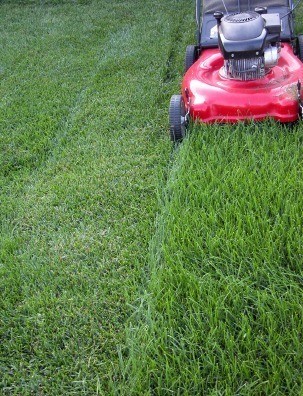Cutting your lawn at the right mowing height is the single most important thing you can do to keep your lawn healthy. Mowing at the correct height reduces weed problems, contributes to a healthy root system, increases resistance to drought, insects, and diseases, and helps prevent run-off of soil, fertilizers, chemicals, and pollutants.
When choosing the best lawnmower height setting, the first thing you need to take into account is what type of grass you are growing.
| Grass species | Set mower height to (inches) | Mow at this height (inches) |
|---|---|---|
| Annual ryegrass | 1 1/2 to 2 | 2 1/4 to 3 |
| Perennial ryegrass | 1 1/2 to 2 1/2 | 2 1/4 to 3 3/4 |
| Bahia grass | 1 1/2 to 3 | 2 1/4 to 4 1/2 |
| Bermuda grass, common | 1 to 1 1/2 | 1 1/2 to 2 1/4 |
| Bermuda grass, hybrid | 1/2 to 1 | 3/4 to 1 1/2 |
| Creeping Bentgrass | 1/2 to 1 | 3/4 to 1 1/2 |
| Hard fescue | 1 1/2 to 2 1/2 | 2 1/4 to 3 3/4 |
| Kentucky bluegrass | 1 1/2 to 2 1/2 | 2 1/4 to 3 3/4 |
| St. Augustine grass | 1 to 2 | 1 1/2 to 3 |
| Tall fescue | 1 1/2 to 3 | 2 1/4 to 4 1/2 |
| Zoysiagrass | 1/2 to 1 | 3/4 to 1 1/2 |
| Buffalo grass | 1 to 2 | 1 1/2 to 3 |
Grass species have a range of recommended mowing heights, and the chart above is only meant to be a guideline. Lawn experts recommend staying toward the upper end of the ranges given-especially during stressful conditions such as hot weather or drought, or if your lawn is growing in the shade. In cooler weather and under ideal conditions, you can afford to cut the grass a little lower. If you are unsure what type of grass species you have growing, cutting it at a height of 2 1/2 to 3 inches will work for the majority of grass varieties.
For a healthy lawn, never cut more than one-third of the grass blade during any one mowing session. If your lawn grows too long, due to wet weather or a busy schedule, increase the cutting height of your mower to the highest possible setting before you mow. Then move the cutting height back to your normal range and cut the lawn again four or five days later.
If you stick to the 1/3 rule, you should never have to worry about bagging the clippings, because the grass clippings will always be short enough to filter down to the soil's surface to decompose and recycle nutrients back into your lawn.
Mowing your lawn at the correct height keeps the growth thick and vigorous, and reduces the growth of broad-leafed weeds-according to some studies, by as much as 50 to 80%. To set the mowing height on a rotary lawn mower, adjust the blade height levers at each of the lawnmower's wheels. Place the mower on a flat surface like a driveway or sidewalk and push each lever to the setting recommended above.

About The Author: Ellen Brown is an environmental writer and photographer and the owner of Sustainable Media, an environmental media company that specializes in helping businesses and organizations promote eco-friendly products and services.
Add your voice! Click below to comment. ThriftyFun is powered by your wisdom!
choosing the height is not easy...am i suppose to take out a measuring stick to see the length???
Cut it short so you mow it once o month
I bet your yard is the envy of the neighborhood.
I'd never cut my grass as low as 2". Minimum grass length for me is 3".
Stays greener longer in heat and keeps weeds at bay. Also I don't bag cuttings except when leaf season arrives.
Good points raised in this piece.
Practice this motto: Cut it high and let it lie, i.e. bagging clippings is largely unnecessary as they shrink to invisibility and help keep the soil cool and fertilized.
Also, save your self time and money when it comes to fertilizer: do it once a year, in September, perhaps in conjunction with overseeding. The reason is that fertlilizer applied in the fall stimulates root growth while fertilizer over the growing season stimulates blade growth.
Add your voice! Click below to comment. ThriftyFun is powered by your wisdom!